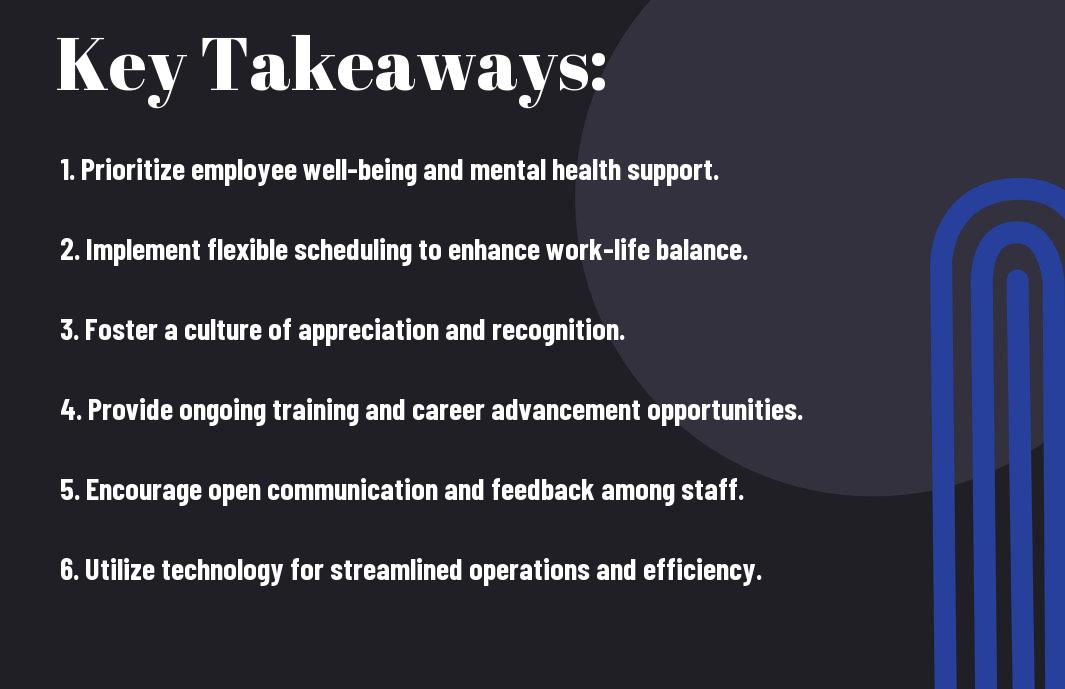Workforce stability is necessary for your senior care organization’s success and sustainability. If you want to combat high turnover rates and create a stronger, more dedicated team, you need to implement innovative retention strategies that meet the unique needs of your employees. This blog post will guide you through effective practices that not only enhance job satisfaction but also promote long-term commitment in your workforce, ultimately leading to improved care for your residents.
Key Takeaways:
- Implement flexible scheduling and work-life balance initiatives to accommodate the needs of staff, enhancing job satisfaction and reducing turnover.
- Foster a culture of recognition and appreciation, where contributions are acknowledged, promoting employee engagement and loyalty.
- Invest in professional development opportunities, allowing employees to grow their skills and careers within the organization, which can increase retention rates.
Understanding Workforce Resilience
Your senior care organization’s strength relies on a resilient workforce, which is the ability of your employees to adapt, recover, and thrive amidst challenges. In an ever-evolving healthcare environment, understanding workforce resilience helps you create a supportive atmosphere that not only improves employee satisfaction but also enhances the quality of care your organization delivers. Implementing strategies that foster resilience can lead to improved staff retention, ultimately benefiting the residents you serve.
Defining Resilience in Senior Care
Resilience in senior care is the capability of staff to bounce back from stress, cope with uncertainties, and remain engaged in their work. It encompasses emotional, social, and physical adaptability, ensuring that caregivers can not only handle the rigors of their roles but also support the well-being of their residents. By fostering a culture that encourages personal growth and teamwork, you create a robust environment that promotes long-term stability and satisfaction.
Importance of Retention in Healthcare
An effective retention strategy is vital in healthcare, particularly in senior care, where consistent staffing directly impacts the quality of patient care. High turnover rates can lead to disrupted care continuity, affecting both the emotional and physical well-being of residents. Stabilizing your workforce not only enhances the resident experience but also boosts morale among remaining staff, resulting in better outcomes for everyone involved.
Consequently, investing in employee retention strategies can reduce recruitment costs and lost productivity. When your employees feel supported and valued, they are less likely to leave, leading to a more experienced and knowledgeable workforce. This not only enhances the care provided to residents but also fosters a sense of community and stability within your organization. Prioritizing retention can improve team cohesion and promote a positive work environment, ultimately leading to better healthcare outcomes.
Innovative Retention Strategies
Clearly, implementing innovative retention strategies is vital for senior care providers looking to cultivate a resilient workforce. These strategies not only enhance employee satisfaction but also improve the quality of care delivered to residents. By recognizing and addressing the unique needs of your staff, you can create an environment that fosters loyalty, engagement, and long-term commitment.
Incentive Programs and Benefits
Benefits of attractive incentive programs go beyond mere financial compensation. They can include flexible scheduling, bonus structures, and comprehensive health plans. By tailoring these offerings to meet your staff’s diverse needs, you can significantly elevate morale and retention rates, making your workplace a desirable environment to contribute to.
Career Development and Training
Incentive programs are a vital component of employee retention, but an equally significant aspect is ensuring effective career development and training opportunities. Your workforce thrives when you invest in their growth through tailored training, mentorship, and clearly defined career pathways. A structured approach toward skill enhancement not only empowers your employees but also raises the quality of care they provide. By fostering a culture that celebrates continuous learning and professional advancement, you position your organization as a leader in the senior care industry, demonstrating to staff that their future is valued and secure.

Creating a Supportive Work Environment
For senior care providers, fostering a supportive work environment is vital to enhance employee satisfaction and retention. This means cultivating a culture that values open communication, prioritizes well-being, and encourages professional development. By focusing on support systems, staff members feel more empowered and connected, ultimately leading to a more resilient workforce capable of facing daily challenges with confidence.
Leadership and Management Approaches
Above all, effective leadership plays a pivotal role in creating a supportive workplace. You should engage in transparent communication practices, actively listen to your team, and provide consistent feedback. A management style that emphasizes collaboration and directs resources towards staff needs not only enhances morale but also strengthens loyalty, making your retention efforts more successful.
Building Strong Team Dynamics
Team dynamics greatly influence employee satisfaction and effectiveness in senior care settings. You and your colleagues should work together seamlessly, fostering relationships built on trust and respect. By encouraging *open dialogue*, *active collaboration*, and *mutual understanding*, you will create an environment where everyone feels valued and motivated to contribute. This collective spirit not only serves clients better but empowers your team to face challenges with greater resilience.
To build strong team dynamics, you must invest time in team-building activities and open communication channels. These initiatives not only help in strengthening interpersonal relationships but also promote a culture of trust and accountability. When you understand each other’s strengths and weaknesses, the team can navigate challenges more effectively. Establishing clear goals and celebrating achievements together fosters a sense of belonging and alignment. As a result, individuals bring their best selves to work, creating a positive and *productive environment* that ultimately enhances resident care and reduces turnover.
Employee Well-being Initiatives
Unlike traditional approaches that focus solely on compensation, modern employee well-being initiatives prioritize a holistic view of healthcare workers’ needs. By creating an environment that nurtures both physical and mental health, your organization can enhance job satisfaction and retention rates. The right initiatives not only support your employees but also contribute to a more productive and engaged workforce, ultimately improving care quality for the seniors you serve.
Mental Health Support
Around 1 in 5 adults in the U.S. experience mental illness each year, making mental health support an crucial component of employee well-being. By offering resources such as counseling services, access to mental health professionals, and stress-relief workshops, you empower your staff to manage challenges effectively. Promoting an open dialogue about mental health can also help reduce stigma, creating a safer environment for your team.
Work-Life Balance Programs
Any strategy that fosters work-life balance is vital for retaining your best staff. Implementing flexible scheduling, remote work options, and wellness days acknowledges the personal lives of your team and helps them to manage their responsibilities outside of work.
And when you establish proper work-life balance programs, you allow your employees to recharge, reducing the risk of burnout and fatigue. Providing opportunities for flexibility can lead to improved job satisfaction and loyalty, as your team feels valued and understood. Incorporating initiatives such as mental health days, childcare assistance, and predictable schedules can significantly enhance productivity and overall morale. As a result, your commitment to your employees’ well-being will reflect in the quality of care they provide—a win-win for everyone involved.
Leveraging Technology for Retention
Not only can technology improve the quality of care in senior care settings, but it can also enhance employee retention by fostering a supportive work environment. By investing in digital tools and platforms tailored for your workforce, you can streamline communication, boost engagement, and minimize administrative burdens that often lead to burnout. The right tech solutions empower employees, making their jobs easier while keeping them committed to your mission.
Tools for Communication and Engagement
Around the workplace, effective communication platforms can play a significant role in keeping your staff informed and engaged. Utilizing messaging apps or collaboration tools facilitates real-time connection and teamwork, enhancing morale and making employees feel valued. When you invest in robust communication technologies, you not only provide your team with the information they need, but also foster a sense of community that is indispensable for retention.
Streamlining Administrative Tasks
Any senior care provider knows that managing administrative tasks efficiently can significantly impact employee satisfaction. Implementing automated systems for scheduling, payroll, and documentation can help reduce the time spent on tedious responsibilities, allowing your staff to focus on patient care. By investing in technology that simplifies these processes, you create an environment where your team can thrive rather than become overwhelmed.
This streamlining of administrative tasks is vital to maintaining a healthy work-life balance for your team. By minimizing time-consuming responsibilities, you reduce the likelihood of burnout and increase job satisfaction. Employees no longer have to stress about inefficient workflows that detract from their commitment to care. Instead, they can focus on what truly matters: providing excellent care to seniors. Therefore, when you prioritize technology that addresses administrative challenges, you foster a positive work environment that keeps your workforce engaged and loyal.

Measuring Retention Success
All senior care providers must focus on measuring retention success to understand the effectiveness of their strategies. This involves analyzing various aspects, from employee turnover rates to engagement levels, enabling you to identify areas needing improvement. Establishing a framework for assessment ensures that you can track the progress of your initiatives and adapt your approach to maintain a resilient workforce.
Key Performance Indicators
Below are some key performance indicators (KPIs) that can help you gauge your retention strategies’ effectiveness. These include employee turnover rates, average tenure, engagement scores, and exit interview feedback. By regularly monitoring these metrics, you can draw insightful conclusions and adjust your practices to enhance employee satisfaction and retention rates.
Feedback Mechanisms and Surveys
Before implementing retention strategies, you should gather employee feedback through surveys and other mechanisms. This approach helps you understand your workforce’s needs and preferences, enabling you to create a more supportive environment.
It’s necessary to establish regular feedback mechanisms such as anonymous surveys or open forums, allowing employees to voice their opinions. This practice not only highlights areas you need to address but also fosters a positive workplace culture where employees feel valued and heard. High participation in these surveys is a good indicator of engagement, and addressing the feedback received can lead to better retention rates and a more harmonious workplace.

To wrap up
Ultimately, by implementing innovative retention strategies, you can foster a resilient workforce in your senior care organization. These strategies not only enhance employee satisfaction but also improve the overall quality of care for your clients. As you focus on meeting the needs of your staff, you contribute to creating a supportive environment that minimizes turnover and boosts morale. For more insights on this topic, explore Building a Resilient Workforce to strengthen your approach in this challenging field.
FAQ
Q: What are some effective retention strategies for senior care providers to build a more resilient workforce?
A: There are several innovative retention strategies senior care providers can implement to foster a resilient workforce. Firstly, creating a positive and inclusive workplace culture is important. This can be achieved through regular team-building activities, open communication channels, and recognition programs that celebrate employee achievements. Secondly, offering competitive compensation packages alongside comprehensive benefits, such as healthcare, retirement plans, and wellness programs, can significantly enhance job satisfaction. Additionally, providing opportunities for professional development, such as training sessions and career advancement paths, empowers staff and encourages long-term commitment to the organization.
Q: How can senior care providers effectively measure the success of their retention strategies?
A: Senior care providers can gauge the effectiveness of their retention strategies through various methods. Conducting regular employee surveys can provide insights into job satisfaction, engagement levels, and areas needing improvement. Monitoring turnover rates and exit interview feedback can also highlight reasons for employee departures and identify trends. Moreover, tracking employee performance and productivity levels before and after implementing new strategies can offer quantitative evidence of their success. All this data can help providers refine their approaches and ensure they meet the needs of their workforce.
Q: What role does leadership play in enhancing workforce resilience within senior care settings?
A: Leadership plays a pivotal role in enhancing workforce resilience in senior care settings. Effective leaders must cultivate an environment where employees feel valued and heard. This involves transparent communication, where leaders regularly share organizational goals and encourage staff feedback. Furthermore, leaders should prioritize employee well-being by promoting work-life balance and actively supporting mental health initiatives. Leaders who demonstrate empathy and authenticity in their approach can inspire their teams and create a stable and resilient workforce poised to meet the challenges of senior care provision.







